ECU SAAB 9-3 2000 Owners Manual
[x] Cancel search | Manufacturer: SAAB, Model Year: 2000, Model line: 9-3, Model: SAAB 9-3 2000Pages: 236, PDF Size: 10.85 MB
Page 1 of 236
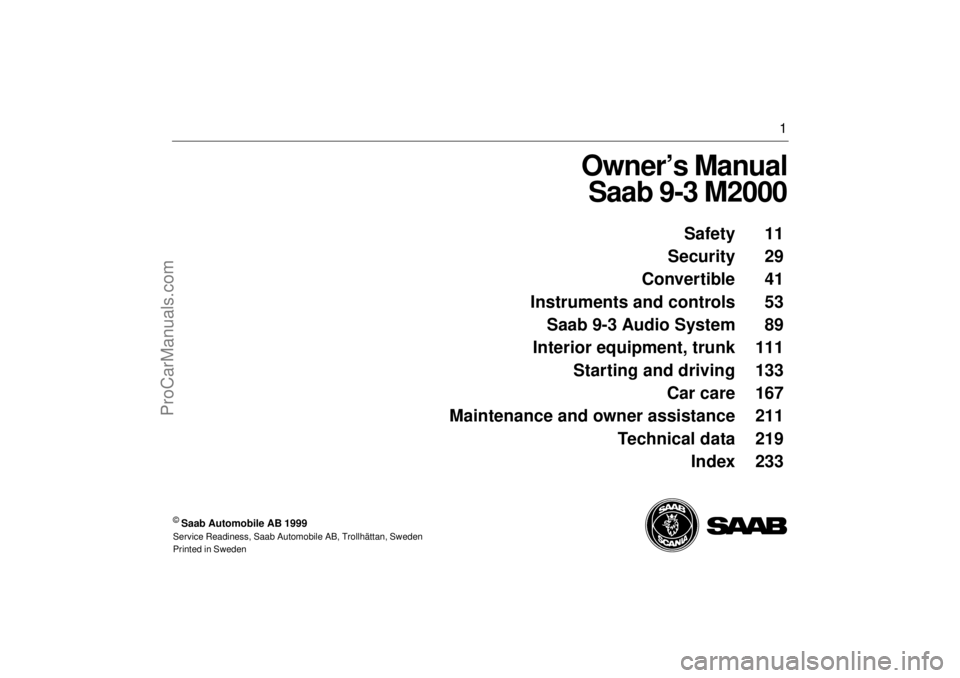
1
Owner’s Manual
Saab 9-3 M2000
© Saab Automobile AB 1999 Service Readiness, Saab Automobile AB, Trollhättan, Sweden
Printed in Sweden
Safety 11
Security 29
Convertible 41
Instruments and controls 53
Saab 9-3 Audio System 89
Interior equipment, trunk 111
Starting and driving 133
Car care 167
Maintenance and owner assistance 211
Technical data 219
Index 233
ProCarManuals.com
Page 8 of 236
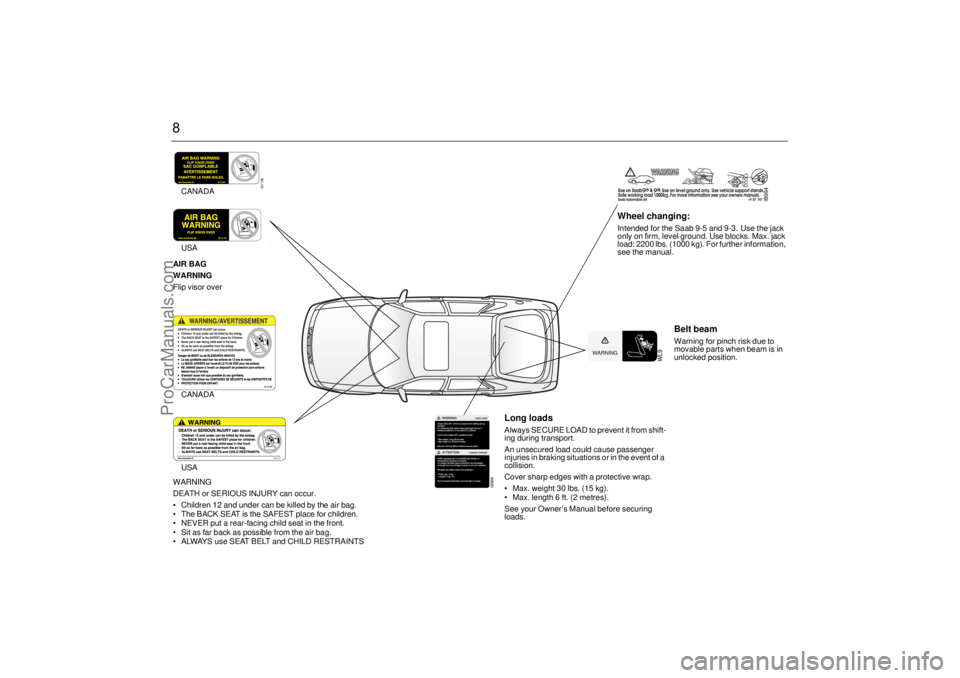
8
Long loads Always SECURE LOAD to prevent it from shift-
ing during transport.
An unsecured load could cause passenger
injuries in braking situations or in the event of a
collision.
Cover sharp edges with a protective wrap.
Max. weight 30 lbs. (15 kg).
Max. length 6 ft. (2 metres).
See your Owner’s Manual before securing
loads. IB989
Belt beam Warning for pinch risk due to
movable parts when beam is in
unlocked position.
WARNING
WL9
Wheel changing: Intended for the Saab 9-5 and 9-3. Use the jack
only on firm, level ground. Use blocks. Max. jack
load: 2200 lbs. (1000 kg). For further information,
see the manual.
IB994
AIR BAG
WARNING
Flip visor over
50 10 111
WARNING
DEATH or SERIOUS INJURY can occur.
Children 12 and under can be killed by the air bag.
The BACK SEAT is the SAFEST place for children.
NEVER put a rear-facing child seat in the front.
Sit as far back as possible from the air bag.
ALWAYS use SEAT BELT and CHILD RESTRAINTS
IB1195
USA CANADA
USACANADA
ProCarManuals.com
Page 14 of 236
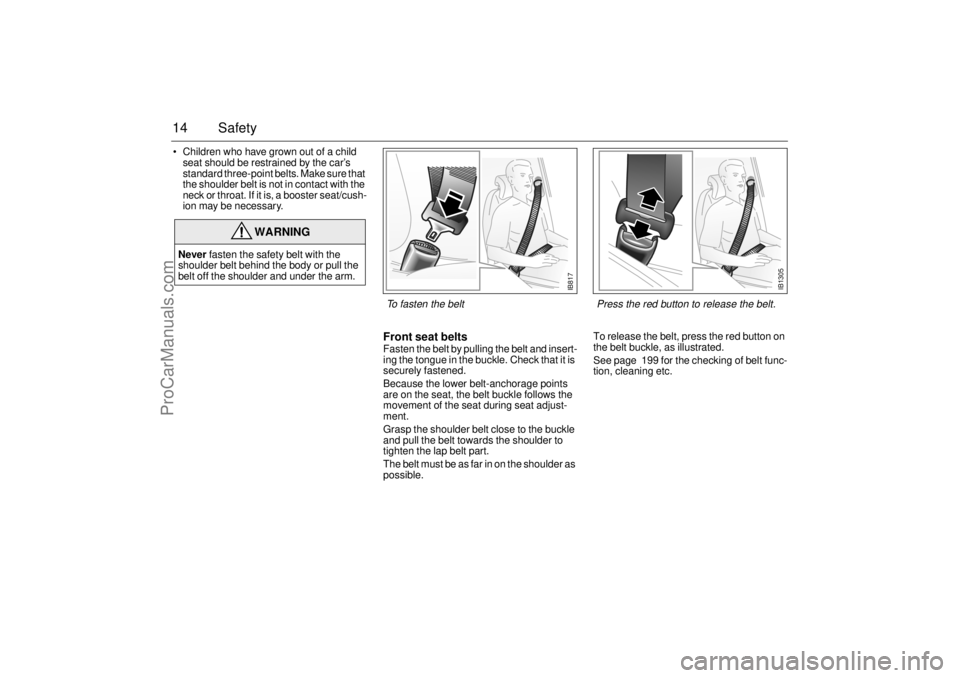
14 Safety Children who have grown out of a child
seat should be restrained by the car’s
standard three-point belts. Make sure that
the shoulder belt is not in contact with the
neck or throat. If it is, a booster seat/cush-
ion may be necessary.
Front seat belts Fasten the belt by pulling the belt and insert-
ing the tongue in the buckle. Check that it is
securely fastened.
Because the lower belt-anchorage points
are on the seat, the belt buckle follows the
movement of the seat during seat adjust-
ment.
Grasp the shoulder belt close to the buckle
and pull the belt towards the shoulder to
tighten the lap belt part.
The belt must be as far in on the shoulder as
possible.To release the belt, press the red button on
the belt buckle, as illustrated.
See page 199 for the checking of belt func-
tion, cleaning etc.
WARNING
Never fasten the safety belt with the
shoulder belt behind the body or pull the
belt off the shoulder and under the arm.
IB817
To fasten the belt
IB1305
Press the red button to release the belt.
ProCarManuals.com
Page 16 of 236
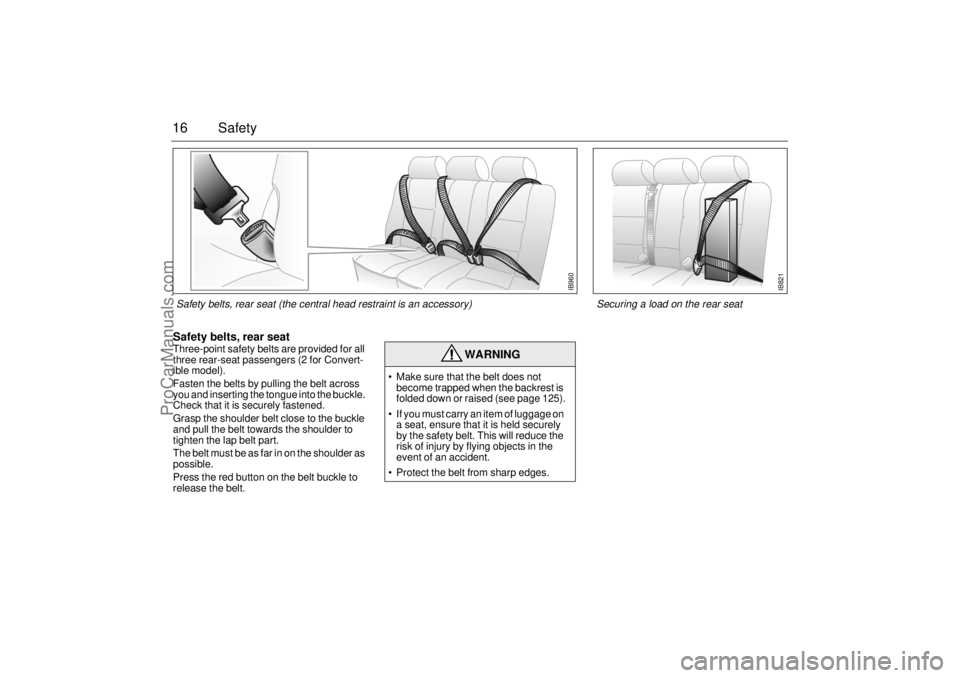
16 SafetySafety belts, rear seat Three-point safety belts are provided for all
three rear-seat passengers (2 for Convert-
ible model).
Fasten the belts by pulling the belt across
you and inserting the tongue into the buckle.
Check that it is securely fastened.
Grasp the shoulder belt close to the buckle
and pull the belt towards the shoulder to
tighten the lap belt part.
The belt must be as far in on the shoulder as
possible.
Press the red button on the belt buckle to
release the belt.
WARNING
Make sure that the belt does not
become trapped when the backrest is
folded down or raised (see page 125).
If you must carry an item of luggage on
a seat, ensure that it is held securely
by the safety belt. This will reduce the
risk of injury by flying objects in the
event of an accident.
Protect the belt from sharp edges.
IB960
Safety belts, rear seat (the central head restraint is an accessory)
IB821
Securing a load on the rear seat
ProCarManuals.com
Page 18 of 236
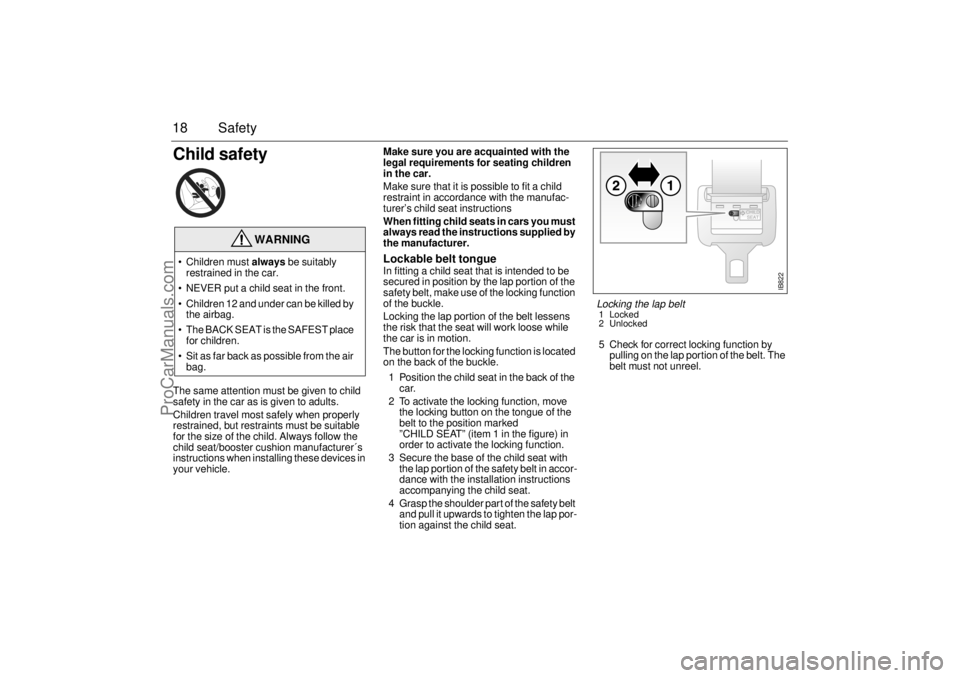
18 SafetyChild safetyThe same attention must be given to child
safety in the car as is given to adults.
Children travel most safely when properly
restrained, but restraints must be suitable
for the size of the child. Always follow the
child seat/booster cushion manufacturer´s
instructions when installing these devices in
your vehicle. Make sure you are acquainted with the
legal requirements for seating children
in the car.
Make sure that it is possible to fit a child
restraint in accordance with the manufac-
turer’s child seat instructions
When fitting child seats in cars you must
always read the instructions supplied by
the manufacturer.
Lockable belt tongue In fitting a child seat that is intended to be
secured in position by the lap portion of the
safety belt, make use of the locking function
of the buckle.
Locking the lap portion of the belt lessens
the risk that the seat will work loose while
the car is in motion.
The button for the locking function is located
on the back of the buckle.
1 Position the child seat in the back of the
car.
2 To activate the locking function, move
the locking button on the tongue of the
belt to the position marked
”CHILD SEAT” (item 1 in the figure) in
order to activate the locking function.
3 Secure the base of the child seat with
the lap portion of the safety belt in accor-
dance with the installation instructions
accompanying the child seat.
4 Grasp the shoulder part of the safety belt
and pull it upwards to tighten the lap por-
tion against the child seat. 5 Check for correct locking function by
pulling on the lap portion of the belt. The
belt must not unreel.
WARNING
Children must always be suitably
restrained in the car.
NEVER put a child seat in the front.
Children 12 and under can be killed by
the airbag.
The BACK SEAT is the SAFEST place
for children.
Sit as far back as possible from the air
bag.
IB822
Locking the lap belt 1 Locked
2 Unlocked
ProCarManuals.com
Page 19 of 236

19 Safety
Child tether anchoragesChild restraints with a tether strap must be
anchored according to law.
WARNING
Child tether anchorages are designed to
withstand only those loads imposed by
correctly fitted child restraints.
Under no circumstances are they to be
used for:
Adult safety belts.
Harnesses.
Attaching other items or equipment to
the vehicle.
Load securing device.
IB1314
Attaching tether strap hook to anchorage,
Conver tible.
The tether strap is not a part of the tether
child anchorage.
IB1362
Child tether anchorage, Coupé and 5-
door models.
The tether strap is not a part of the child
tether anchorage.
ProCarManuals.com
Page 20 of 236

20 SafetyIntegrated booster seat
(accessory)Integrated booster seats are available as
part of the rear seat backrest.
This child restraint is designed for use by
children who weigh between 33 and 80 lbs.
(15 and 36 kg) and are between 38 and 54
inches (970 and 1370 mm) in height.
A child sitting in an integrated booster seat
must use the car’s regular lap and shoulder
belt. Regardless of the child’s weight and
age, proper contact between child and belt
is vital. Always make certain that the seat is
undamaged and is kept clean so that it will
function properly.
This child restraint system conforms to all
applicable motor vehicle safety standards. Folding out 1 Press in the latches and lift and remove
the car’s regular head restraint. Turn it
180° and remount it. Make certain that it
is locked securely in place.
2 Lift up the booster seat’s headrest.
3 Pull out the upper part of the opener
strap and lower the seat itself. Make cer-
tain that it is locked in the lowered posi-
tion.
Fasten the belt See that the child is seated as far back as
possible against the back support.
Adjust the booster seat’s head support so
that its center is at ear height.
To attach the belt, pull it out slowly and
insert the latch plate into the buckle. Make
certain the latch plate is properly engaged
in the buckle.
The lap portion of the belt must be posi-
tioned low on the pelvis, and the shoulder
strap must be as far in on the shoulder as
possible without chafing against the
child’s neck or causing discomfort.
The belt must contact the body firmly to
provide the best protection. Pull up on the shoulder strap to tension the belt prop-
erly.
Make certain the belt moves freely
between the retractor and the buckle.
IB825
ProCarManuals.com
Page 24 of 236
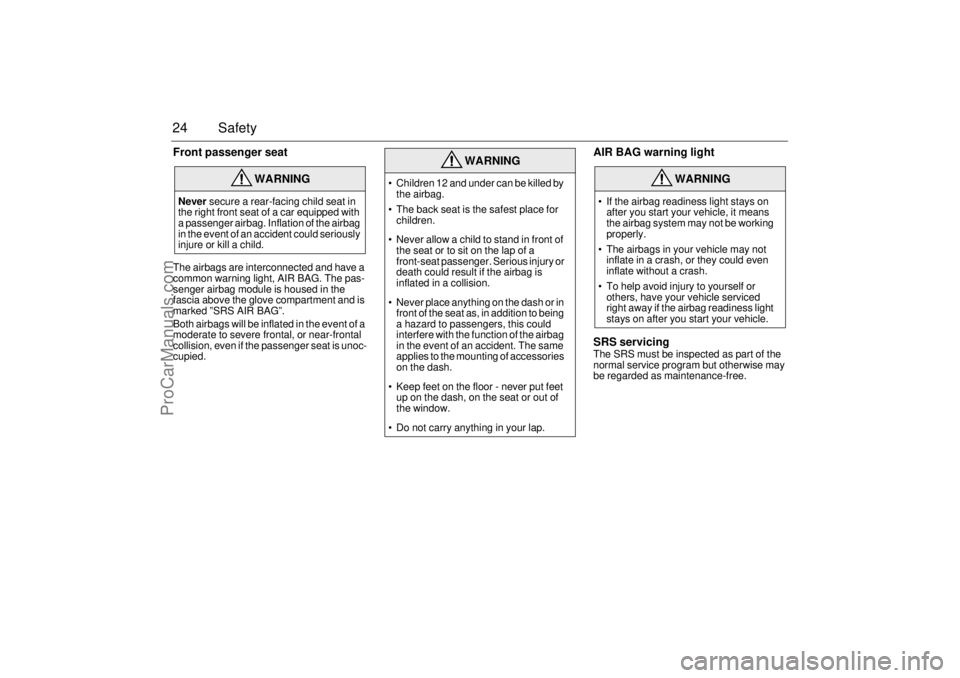
24 SafetyFront passenger seat The airbags are interconnected and have a
common warning light, AIR BAG. The pas-
senger airbag module is housed in the
fascia above the glove compartment and is
marked ”SRS AIR BAG”.
Both airbags will be inflated in the event of a
moderate to severe frontal, or near-frontal
collision, even if the passenger seat is unoc-
cupied.
AIR BAG warning light
SRS servicingThe SRS must be inspected as part of the
normal service program but otherwise may
be regarded as maintenance-free.
WARNING
Never secure a rear-facing child seat in
the right front seat of a car equipped with
a passenger airbag. Inflation of the airbag
in the event of an accident could seriously
injure or kill a child.
WARNING
Children 12 and under can be killed by
the airbag.
The back seat is the safest place for
children.
Never allow a child to stand in front of
the seat or to sit on the lap of a
front-seat passenger. Serious injury or
death could result if the airbag is
inflated in a collision.
Never place anything on the dash or in
front of the seat as, in addition to being
a hazard to passengers, this could
interfere with the function of the airbag
in the event of an accident. The same
applies to the mounting of accessories
on the dash.
Keep feet on the floor - never put feet
up on the dash, on the seat or out of
the window.
Do not carry anything in your lap.
WARNING
If the airbag readiness light stays on
after you start your vehicle, it means
the airbag system may not be working
properly.
The airbags in your vehicle may not
inflate in a crash, or they could even
inflate without a crash.
To help avoid injury to yourself or
others, have your vehicle serviced
right away if the airbag readiness light
stays on after you start your vehicle.
ProCarManuals.com
Page 29 of 236
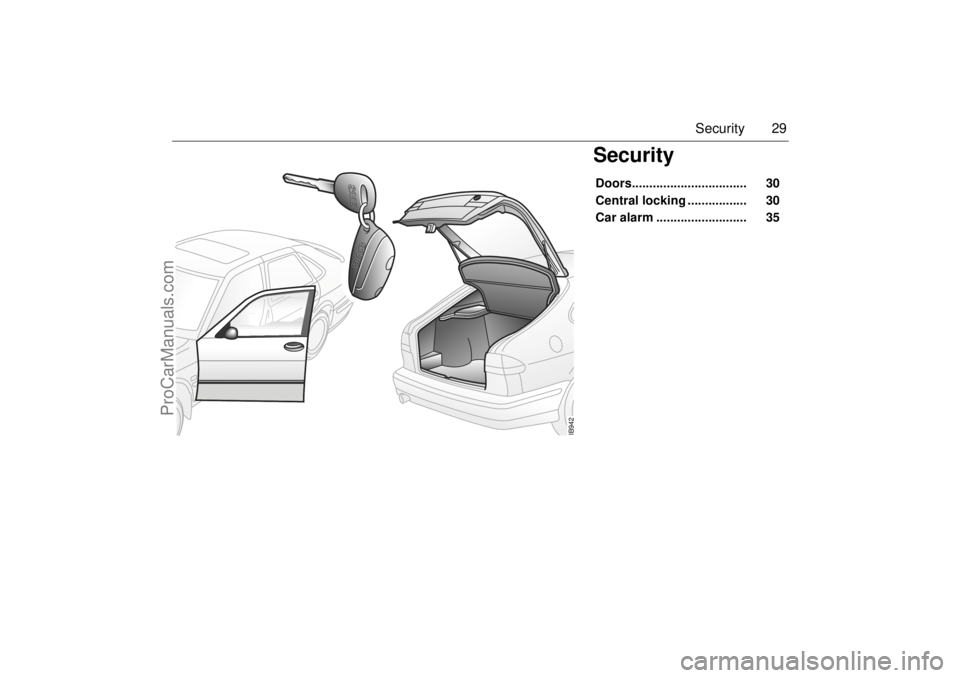
29 Security
SecurityDoors................................. 30
Central locking ................. 30
Car alarm .......................... 35
IB942
ProCarManuals.com
Page 30 of 236

30 SecurityDoorsOpening handleOpen the door by lifting the opening handle
from below.
If the door is stuck (e.g. if frozen), hold the
handle from above to secure a better grip.
Central locking Key / Remote control The key fits all the locks on the car. The
spare key without the black key grip only fits
the door locks.
The key supplied with the car has a code
number on a black plastic tag that needs to
be quoted for ordering additional keys. You
should therefore make a careful note of the
number.
The key contains a unique electronic code
for your car. When the key is inserted in the
ignition, the code is checked. If it matches,
the car can be started.
Two keys/remote controls are supplied with
the car. It is possible to have up to four at
one time that are coded for your car. If one
is lost, contact your authorized Saab dealer
to obtain a replacement. If an additional
remote or key is to be added, all of the orig-
inal keys and remotes must be brought to
the dealer so that the control module can
‘’learn” to recognize the new components.
For this reason, we strongly advise you to
take two keys with you on long journeys and
to keep them separate.The remote control contains delicate elec-
tronics and should therefore not be exposed
to water or handled roughly.
WARNING
Leaving children or pets unattended in a
locked car is dangerous. It is also danger-
ous to leave children in a vehicle with the
ignition key. A child or others could be
badly injured or even killed.
IB844
Door handle
I B 111 6
123
Remote control 1To lock
2 To unlock
3 To unlock trunk lid
To open trunk lid (Convertible)
ProCarManuals.com